
A trestle bridge is a bridge composed of a number of short spans supported by closely spaced frames. A trestle is a rigid frame used as a support, historically a tripod used to support a stool or a pair of isosceles triangles joined at their apices by a plank or beam such as the support structure for a trestle table. Each supporting frame is a bent. A trestle differs from a viaduct in that viaducts have towers that support much longer spans and typically have a higher elevation.

The Northern Central Railway (NCRY) was a Class I Railroad in the United States connecting Baltimore, Maryland, with Sunbury, Pennsylvania, along the Susquehanna River. Completed in 1858, the line came under the control of the Pennsylvania Railroad (PRR) in 1861, when the PRR acquired a controlling interest in the Northern Central's stock to compete with the rival Baltimore and Ohio Railroad (B&O).
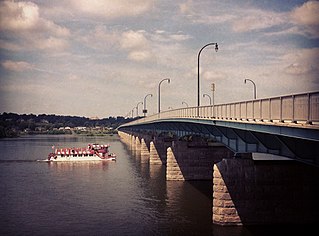
The M. Harvey Taylor Bridge is a steel girder multilane highway bridge that spans the Susquehanna River, connecting Pennsylvania state capital Harrisburg to Wormleysburg in Cumberland County. Built in the early 1950s, it was reconstructed and widened in 2001-04 to accommodate additional pedestrian walkways. The speed limit is 50 miles per hour . The Average Daily Traffic in 2016 was 28,139, only 2% of which was trucks. The bridge has never had a route designation.

The Columbia–Wrightsville Bridge, officially the Veterans Memorial Bridge, spans the Susquehanna River between Columbia and Wrightsville, Pennsylvania, and carries Pennsylvania Route 462 and BicyclePA Route S. Built originally as the Lancaster-York Intercounty Bridge, construction began in 1929, and the bridge opened September 30, 1930. On November 11, 1980, it was officially dedicated as Veterans Memorial Bridge, though it is still referenced locally as the Columbia–Wrightsville Bridge.

The Coraopolis Bridge[1] is a girder bridge over the back channel of the Ohio River connecting Grand Avenue on Neville Island to Ferree Street in Coraopolis, Pennsylvania. It opened in 1995 to replace a structure of historic significance. The original Pratt/Bowstring/Pennsylvania[2] through truss spans, designed by Theodore Cooper, were formerly the (third) Sixth Street Bridge, spanning the Allegheny River, in downtown Pittsburgh, and were built in 1892 by the Union Bridge Company. They were floated downstream by the Foundation Company in 1927 rather than being demolished when the bridge was removed to enable construction of the present (fourth) Three Sisters (Pittsburgh) Sixth Street Self-anchored suspension bridge. However, by the late 1980s, the old bridge could no longer support traffic volumes and was replaced by a newer structure.
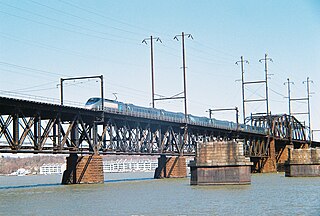
The Amtrak Susquehanna River Bridge is a deck truss bridge that carries the Amtrak Northeast Corridor line across the Susquehanna River between Havre de Grace and Perryville, Maryland. The 4,153.8-foot (1,266.1 m)-long two-track bridge has 17 fixed spans and one swing span across the river's navigation channel. It carries up to 114 daily passenger and freight trains.

The CSX Susquehanna River Bridge is a railroad bridge that carries CSX's Philadelphia Subdivision across the Susquehanna River between Havre de Grace and Perryville, Maryland, via Garrett Island. It was built in 1907–1910 by the Baltimore and Ohio Railroad (B&O) on the same alignment as an 1886 B&O bridge. Like its predecessor, it was the longest continuous bridge on the B&O system.

The Pennsylvania Railroad Bridge once carried the York Branch of the Pennsylvania Railroad across the Susquehanna River between Columbia and Wrightsville, Pennsylvania and is therefore considered a Columbia-Wrightsville Bridge. It and its predecessors were a vital commercial and passenger linkage between Philadelphia and Baltimore for over 100 years.

The Philadelphia & Reading Railroad Bridge carries Norfolk Southern rail lines across the Susquehanna River between Lemoyne, Pennsylvania and Harrisburg, Pennsylvania. Some of its concrete piers encase stone masonry piers from an earlier truss bridge on this site, completed in 1891 by the Philadelphia, Harrisburg and Pittsburgh Railroad, which was then acquired by the Philadelphia and Reading Railroad to connect its Harrisburg and Lurgan lines. The current structure was constructed from 1920 to 1924 by replacing the trusses with concrete arches one track at a time. The bridge has fifty-one concrete arches, three more than the nearby Rockville Bridge.
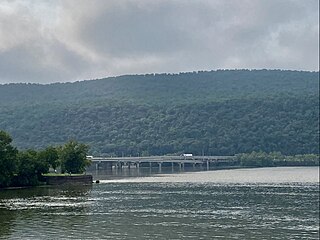
The Clarks Ferry Bridge is a plate girder bridge that carries U.S. Routes 22 and 322 across the Susquehanna River near Duncannon, Pennsylvania, about 20 miles north of Harrisburg, Pennsylvania. It is a 4 lane expressway standard bridge. The bridge also provides safe passage for hikers, bikers, and pedestrians using the Appalachian Trail and BicyclePA Route J. It was completed in November 1986 replacing a 1925 concrete arch toll bridge. At this location, 7 different bridges have crossed the river.
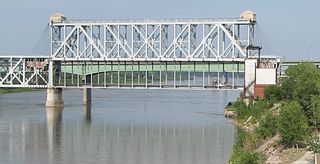
The Armour-Swift-Burlington (ASB) Bridge, also known as the North Kansas City Bridge and the LRC Bridge, is a rail crossing over the Missouri River in Kansas City, Missouri, that formerly also had an upper deck for automobile traffic.
The South Pennsylvania Railroad Bridge was a proposed structure that would have carried the South Pennsylvania Railroad rail lines across the Susquehanna River between Cumberland County, Pennsylvania and Harrisburg, Pennsylvania. Work began on the South Penn and was abruptly halted by banker J. P. Morgan in 1885 when he called a truce in the railroad wars that threatened to undermine investor confidence in the Pennsylvania and New York Central railroads. Of the twenty three piers originally built, eight piers still rise from the water at the west side of the river near the Philadelphia & Reading Railroad Bridge.
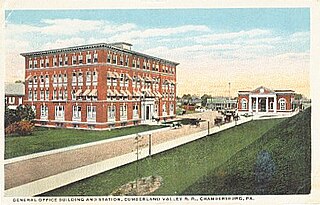
The Cumberland Valley Railroad was an early railroad in Pennsylvania, United States, originally chartered in 1831 to connect with Pennsylvania's Main Line of Public Works. Freight and passenger service in the Cumberland Valley in south central Pennsylvania from near Harrisburg to Chambersburg began in 1837, with service later extended to Hagerstown, Maryland, and then extending into the Shenandoah Valley to Winchester, Virginia. It employed up to 1,800 workers.
The Harrisburg, Portsmouth, Mountjoy & Lancaster Rail-Road (HPMtJ&L) was an early American railroad built to connect three main population centers in east-central Pennsylvania.

The Carl E. Stotz Memorial Little League Bridge, formerly known as the Market Street Bridge, carries approximately 27,700 vehicles a day on U.S. Route 15 over the West Branch Susquehanna River between Williamsport and South Williamsport in Lycoming County, Pennsylvania, in the United States. It is the seventh bridge on the site and was built at a cost of over $60,000,000.

The Skinners Falls–Milanville Bridge is a closed bridge spanning the Delaware River between Milanville, Damascus Township, Pennsylvania and the hamlet of Skinners Falls in Cochecton, New York. The 466.5-foot (142.2 m) long Baltimore truss bridge carried traffic of Calkins Road in Milanville and Skinners Falls Road in Cochecton over a single wooden lane of traffic until its final closure in October 2019. The bridge is one of two bridges on the National Register of Historic Places along the river in Sullivan County, and is a contributing member of the Milanville Historic District.

The Barryville–Shohola Bridge is the fifth generation of bridges constructed over the Delaware River at the communities of Shohola Township, Pennsylvania and Barryville, New York. The bridge serves both communities, with two major state legislative highways, Pennsylvania Traffic Route 434 and New York State Touring Route 55. The bridge itself is 812 feet (247 m) long and is 23 feet (7.0 m) wide, using four total spans across the river. It is maintained by the NY–PA Joint Interstate Bridge Commission, which is jointly owned by the states of New York and Pennsylvania.

The Hill to Hill Bridge is a road crossing of the Lehigh River and linking the south and north sides of Bethlehem, Pennsylvania in the Lehigh Valley region of eastern Pennsylvania.
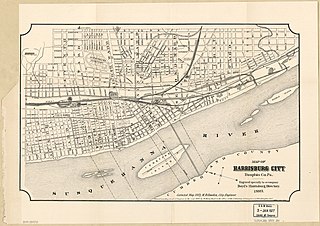
This is a timeline of the major events in the history of Harrisburg, Pennsylvania and vicinity.

The Sunbury and Lewistown Railroad was a Class I Railroad connecting Lewistown, Pennsylvania with Sunbury, Pennsylvania. Completed in December 1871, the line was placed under an immediate lease by the Pennsylvania Railroad (PRR), upon its completion. Although retaining its own board of directors and track maintenance, all locomotive traffic was owned by the PRR. For over eighty years, the line operated between Sunbury and Lewistown, serving as a relief line for both the Philadelphia Main Line and Bald Eagle Valley Railroad through Williamsport, Pennsylvania. The line was noteworthy as a proving ground for new railroad technology in the United States, such as the X-shaped railroad crossing signs in 1917 and Pulse Code Cab Signaling technology in 1925. It is now a fallen flag railway, the name "Sunbury and Lewistown" having been phased out in 1901 when the line became part of the Pennsylvania Railroad's Sunbury Division.




















